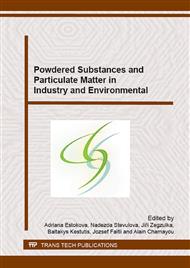p.34
p.40
p.48
p.57
p.65
p.71
p.77
p.88
p.94
Surface Analysis of Plastic Materials PET by XPS Method
Abstract:
The motivation for this study was the increasing need of recycling waste plastics in the cleanest - separated form. Relatively inexpensive methods of physicochemical separation of plastics is based on the different wettability of their surfaces. Because most used polymers are relatively highly hydrophobic, which would lead to their collective flotation in water, the study was aimed for the selective suppression of the hydrophobic character - hydrophilization of one of the most common plastics, which is PET. XPS method gave interesting information about the actual mechanism of the chemical reactions at the PET surface, which was changed by the alkaline hydrolysis.
Info:
Periodical:
Pages:
65-70
Citation:
Online since:
October 2015
Authors:
Keywords:
Price:
Сopyright:
© 2016 Trans Tech Publications Ltd. All Rights Reserved
Share:
Citation:


